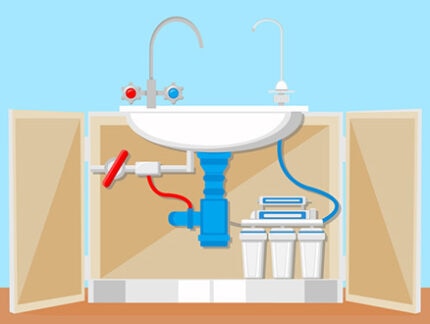Iron is a macro-nutrient that is essential in our daily bodily functions. However, it poses a significant problem when it gets in the wrong places. One of such places is in water, especially well water. Iron in well water is very problematic, and getting it out can be a Herculean task.
Did you recently move somewhere that has a well as the water source? Do you suspect the muddy color is iron and need to get it out? Then, it would help if you read our article on how to remove iron from well water.

Signs Your Well Water Is Contaminated With Iron
If you’re still unsure, let’s talk about some signs of possible contamination.
Water with iron smells and tastes nasty. It isn’t palatable to drink as it has a metallic flavor. Have you ever tasted your bloody lip? Yeah, then you know the taste of iron in the water. Nobody wants to drink that on any day instead of clean, refreshing water.
Another telltale sign is the color of your water. If your water has a muddy or orangey color, leaves stains, and discolorations, you have iron present.
How Does Iron Get Into Well Water?
Iron is a very plentiful mineral on the Earth’s surface. It contributes 32.1% by mass to the minerals found in the Earth’s crust and is present in the soil, rocks, etc. Hence, it is pretty easy for it to get into wells no matter how well they are maintained.
There are two ways iron can get into your well water. They include
Seepage: When rain falls or snow melts, it seeps through the soil and rocks. As surface water seeps through the soil or rock, it will collect any residual iron present in the ground. Iron picked up in the process of percolation will end up in the underground water source.
Corrosion: When exposed to water and oxygen, iron breaks down. This process is called oxidation, and its by-product is rusting.
Suppose the plumbing, casings, and fittings for your well are made from iron materials. In that case, you are very likely to have corrosion as time passes. As this happens, the rust peels off and winds up in the water, traveling up into our faucets.
Effects of Iron Contamination
Iron is essential in our daily bodily functions, but it would be detrimental in large doses. However, it is impossible to overdose on iron by consuming glasses of water.
I bet the primary question on your lip is, “so, Is iron in well water harmful to my health?”
According to the Environmental Protection Agency, iron contamination is secondary contamination. It is simply physical or esthetic contamination and has no direct effect on your health. The EPA maximum standard for such contaminants is 0.3 milligrams per liter. However, iron is seldom found at concentrations more than 10mg/l.
Great, iron in your well water won’t harm you. It can cause other types of damages, though, so let’s look at them.
Unpleasant taste and smell:
The presence of iron in well water will always give it an off-putting metallic smell and taste. The smell and taste are very akin to that of blood. Iron makes drinking such water a very unpleasant experience.
Stains and Deposits:
As we mentioned earlier, water contaminated with iron has a characteristic red-orange color. This color stains all surfaces it gets on, from porcelain to aluminum to toilet bowls and countertops. The color from the water or iron bacteria present can also stain your clothes. It is unsightly and tedious to get rid of.
Like dishes, laundry, and appliances, iron-rich water can stain your hair and skin. When absorbed, it attacks your hair the same way peroxide does. Light-colored hair would acquire an orange tint, while dark hair would become darker with red highlights. Hair would, in turn, become dry, brittle, smell metallic, and might change the texture.
As for your skin, iron interacts negatively with the cells causing wrinkles. It clogs pores, and possible skin conditions may arise.
Also, as iron moves through your plumbings, it deposits in pipes, drains, etc. With time, your pumps, faucets, washing machine, and other appliances would get clogged. This clogging could lead to damages that need not-so-cheap repairs.
Unpalatable Food And Beverages:
Due to the metallic taste and color of iron contaminated water, they make food and beverage preparations very awful. When used in making coffee or tea, it results in a dark, inky concoction with a metallic taste. Also, vegetables washed with iron-rich water taste metallic and get dark in color. Food prepared with this water is usually unappealing.
Types of Iron Contaminants
Iron is present in well water in three forms; ferrous, ferric, and bacterial. The individual forms have specific methods for removing them.
Ferrous Iron
Ferrous iron refers to the element in its +2 oxidation state. In water, it is also known as clear water iron because it is invisible to the naked eye. This invisibility is because its particles are fully soluble in water. They also can’t be filtered out.
You will be unaware till red or orange stains start to show in places where water collects over time. Examples include below the water level in the water tanks of toilets, toilet bowls, reservoirs, etc. When it comes in contact with air in the atmosphere or pressure tanks, discoloration forms.
Ferric Iron
Ferric iron refers to the element in its +3 oxidation state. In water, it is also known as orange water iron. Its orange, red, yellow characteristic color is apparent. You can filter out ferric iron because it is a particulate matter.
Bacterial Iron
Also known as organic iron, this is iron present in a bacterial form. These bacterial organisms feed on iron. They leave iron deposits leading to discolorations, unpleasant smells, and tastes. They also leave a red or orange slime that adheres to pipes and fittings.
Their presence might introduce other harmful pathogens in the water. Holding a glass of water up to a light will help you notice orange clumps floating about. You can also see it as a slimy glob in one corner.
How to Remove Iron from Well Water
Unlike municipal water, well water is private, untreated, and unregulated. Water is pumped up from the aquifers in the vicinity into the well. Well water treatment is the responsibility of the well owner.
Water with iron concentrations of more than 3mg/l is contaminated and will need treatment.
Before you proceed with treatment, you will need to test your water. You should have the test done at a state-certified laboratory.
Testing is crucial because it enables you to pick the best treatment method for you. Your water test results should answer these questions:
- What type of iron is in your water?
- Will treatment remove the total iron content (soluble, insoluble & colloidal)?
- What treatment method is suitable for the flow rate in your well?
- Which treatment method or device will effectively remove iron?
Having answered all these questions, we can move on to the methods showing you how to remove iron from well water.
Treating Ferrous Iron
The following are effective in removing ferrous iron from well water.
1. Water Softeners
Water softeners remove minerals responsible for hardness from water. The best water softener for ferrous iron is the ion exchange softener. It works by replacing the positively charged ions of iron with sodium. Ion exchange softeners are capable of removing even low levels of iron.
Your water system must be airtight to keep out oxygen which could turn the ferrous iron ferric. However, if you wish to plan for this contingency, pair it with a sediment pre-filter. This pairing would prevent your water softener from plugging up.
Note that the ratio of iron to water hardness should be balanced for the technique to be foolproof. Also, you would need to maintain your water system from time to time to prolong the resin beds’ longevity by reverse flushing.
2. Chlorination and Filtration
Chlorine in its liquid or pellet form can be added to the water system to remove ferrous iron. It is then paired with water filter treatment to remove the chlorine from the well water before use. This method requires optimal water pressure and constant observation. It often has a long contact time.
3. Manganese Greensand
Manganese Greensand is a natural mineral, but it can also be synthesized. It works with the principle of an oxidizing filter and efficiently removes ferrous iron from well water. On making contact with Manganese, the ferrous iron is oxidized into its insoluble particulate form.
The manganese greensand media then absorb the resulting residue. The pressure for this has to be right. The media needs to be maintained from time to time by treating it with potassium permanganate. This maintenance backflushes the collected iron particles down the drainage. It also regenerates the oxidizing ability of the greensand media.
4. Aeration and Filtration
Injecting the well water with oxygen from the air oxidizes the ferrous iron. Then, the precipitate is filtered out using a high-quality filtration system. This process is temperature-dependent.
5. Ozonation and Filtration
Ozone is a very potent oxidizing agent. When added to the water system, it oxidizes the iron forming a precipitate. The precipitate is then filtered out using a granular activated carbon filter. This method is quite expensive.
Treating Ferric Iron
Manganese Greensand, Chlorination and filtration, Aeration and filtration, and Carbon filters can also be used to remove ferric iron from well water. Another method is using Sediment Filters:
6. Sediment filters
Sediment filters allow water to flow through them while keeping solid matter from getting into the plumbing. Sub-micron sediment filters are particularly effective as they pick up even fine particulate matter. The smaller the rating on your sub-micron filter, the more efficient it will be at picking up iron. Sediment filters also keep dirt, cloudiness, and debris at bay.
However, this method won’t tackle large concentrations of iron. It is ideal for low concentrations in only the ferric form. Your sediment filters need to be changed periodically as the iron is sure to plug them up.
Treating Bacterial Iron
This biofilm is the nastiest of the bunch and can be challenging to tackle, but we have a solution for you.
7. Shock chlorination
Despite being very tedious, this is the most effective solution for bacterial iron. In this method, you introduce a high concentration of chlorine into the well. The high dosage is to disinfect the well, its components, and water properly.
Every nook and cranny of the well needs to be exposed to shock chlorination to be foolproof. The shock will remove the bacteria bound to the iron. An oxidizing agent, sediment filter, or softener can trap the remaining iron.
Conclusion
Iron in your well water can be very upsetting and embarrassing. We hope this article on how to remove iron from well water would be of great help to you. No one should be without clean, potable water.










